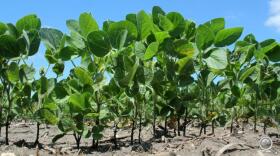
From Kansas Agland:
After a multi-year drought, the scene has changed in Hamilton County.
Trucks filled with grain are lining up at the Syracuse elevator. Combines are out cutting late into the evening. Large mountains of grain sorghum are being piled on the ground at the cooperative and at the town's fairgrounds.
Even the mood is different, said Michele Boy, who was driving a truck and doing chores Tuesday morning before she and her husband, Heath, begin cutting again.
"The past years haven't been good for us," she said, but added about this season's fertile landscape and bountiful milo crop: "It's the prettiest thing to see the fields of rusted red all along the highway."
In fact, she added, at least two fields they farm have yielded more than 100 bushels an acre - some of the best they have ever harvested.
It's the same scenario across western Kansas. Some elevators are beginning to pile milo on the ground because the elevators are full. One farmer in Scott County reported all his fields so far yielding more than 100 bushels an acre.
Ken Jameson, vice president of Garden City Cooperative's grain division, said the co-op is estimating it will take in a record amount of grain sorghum, also called milo.
In 2009, the elevator group took in 8.4 million bushels of milo. The last decent crop was harvested in 2010, Jameson said.
Drought has plagued the region since that time.
Jameson said he's heard of yields between 60 and 157 bushels an acre.
"I’ve never seen that," Jameson said of the top-end yield.
Busy season
Not only are farmers harvesting a bumper milo harvest, they also planted more of it.
Thanks to a good price at planting and demand from countries like China, the state's farmers planted 3.15 million acres to milo last spring, up 17 percent from 2014, according to the October report from the Kansas Agricultural Statistics Service.
Kansas production is forecast at 258 million bushels, up 29 percent from last year.
The agency's weekly report released Monday rates 62 percent of the sorghum and 57 percent of the soybeans as good to excellent.
About half of the state's sorghum and soybeans have been harvested, and corn harvest is wrapping up, the agency said.
Corn harvested was 85 percent, well ahead of 65 last year and ahead of 78 average, according to the Kansas Agricultural Statistics Service.
Jameson said corn harvest is 95 percent complete in his southwest Kansas territory. It was a good harvest - better than last year - but it did not break any records.
Other fall activity
Farmers are busy harvesting other fall crops as well. About 70 percent of the cotton bolls are open, behind 75 percent from last year. Harvest is just beginning in southern Kansas.
According to KASS, cotton condition is 12 percent poor or very poor, 26 fair and 62 percent good to excellent.
Also, sunflowers are 65 percent good to excellent.
Besides harvest, farmers are also finishing up planting winter wheat, the agency reported. Wheat planting is 82 percent complete, ahead of 76 last year. The crop is 51 percent emerged.
Conditions do remain dry across the state. According to the U.S. Drought Monitor, about half of the state is listed as abnormally dry to experiencing a moderate drought. That's compared to 35 percent last week and 25 percent three months ago.
Topsoil moisture is about 60 percent short or very short. Subsoil moisture is 15 percent very short, 37 short and 48 adequate.
Also, pasture and range conditions are 18 percent poor or very poor, 37 percent fair and 45 percent good to excellent. Stock water supplies were 21 percent short, 78 adequate and 1 surplus.
Rain is in the forecast for much of Kansas today through Friday. Most areas have a 70 to 80 percent chance for moisture, which will help the newly planted wheat.












